Wondering what this is all about? The Turn Order writing crew is talking about every game to ever win the Spiel de Jahres award—think of it as the Oscars of Board Gaming. We introduced t he bracket and spent some time with the “Play-In” games in each bracket. You can catch up on all our coverage here.

With the Play-In games done, the main bracket is set. This is what’s known as the Round of 32 in NCAA Tournament parlance; at this point Vegas has slowed down a little bit, due both to the lower number of games and the 2-day hangover starting to set in. The basketball tournament opens with the Round of 64 on Thursday/Friday and moves right into the Round of 32 on Saturday/Sunday before the “student athletes” return to campus to study classes film.
We’re going to go region by region talking about every game, while also picking a winner for each matchup. For those unfamiliar with the terms, winners of the Round of 32 head into the “Sweet 16”. From there it’s on to the “Elite 8” and ultimately the “Final 4”.
Azul
The Number 1 seed in the Northwest is Azaul, a game we like enough around here to have given it a full on Turn Order review. Published by Plan B games, Azul is designed by Michael Kiesling who is no stranger to the Spiel award. He’s a multiple time nominee and award winner.
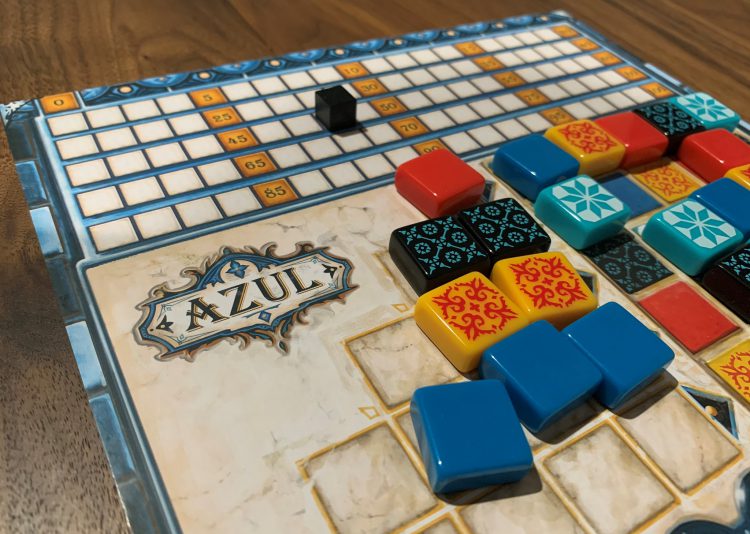
Like many of the best Spiel winners, Azul seems simple. You’ll pick some beautiful plastic tiles out of the center of the table in a pseudo-draft format and place them on your mosaic grid. There are rules for selection and rules for placement, but they’re easy to understand once you start moving pieces around. What makes this game shine and gave it a 1-seed in our bracket is in the accessibility-to-depth ratio.
It doesn’t matter how many board games you have or haven’t played, you can play and enjoy Azul in minutes. The construction of a mosaic means that win or lose you have something to admire, and the various scoring bonuses give you regular hits of dopamine regardless of how well you’re doing. Once you’ve got the hang of it, you’ll find a game that rewards long term thinking and can get downright mean in the draft phase. Azul has spawned some sequels, including a stained glass game we also reviewed, and is a modern classic that should be in print for a good long time.
Heimlich & Co
Also known as Top Secret Spies, Heimlich & Co earned its spot over Villa Paletti on the strength of its hidden information and above-the-table negotiating. It’s a game where you have to help your opponents to hide your position and those games tend to be great. However its run into a buzzsaw of a 1-seed in Azul. For more details, check out our Play-In game article where it had its moment to shine away from the big shadow of Azul.
Camel Up
Since winning the 2014 Spiel des Jahres, Camel Up has quickly become one of the more iconic racing games. Everything about this game is appealing and more or less emblematic of what the modern Spiel des Jahres games are about. Family-friendly fun, rules that are manageably long without being overly complex, fantastic components and a quick playing time. Throw in some dice rolling, betting and the adorable camel figures the players race around the board, and your on for a winner.
Game play is simple. On your turn, you choose one and only one of four actions. First, a player can take a betting tile in the hopes of picking the winner of the race. Earlier picks are worth more than later ones. Second, a player may place their desert tile, changing the board condition. Third, the player can move a camel. To do this requires drawing a pyramid tile and then picking up the three-dimensional pyramid die roller, giving it a shake and revealing a die. The player then moves the camel that many spaces. This leads to one of the more peculiar conditions in the game, because if the camel lands on a square where there is already a camel, the player is instructed to stack the camel they just moved on top of the camel that’s already there. This quickly can lead to a rather tall stack of camels which would then move as a stack. Fourth, the player can bet on which camel will be the overall winner or loser. The player with the most money at the end of the game wins.
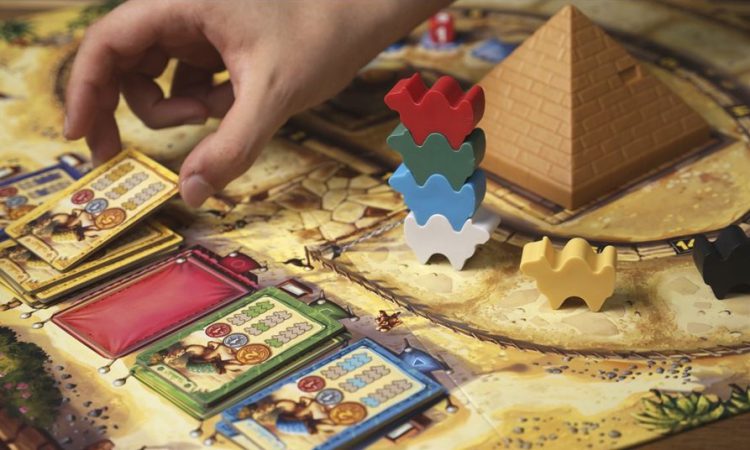
The great advantage of Camel Up over many other racing games is its combination of the racing mechanics with betting mechanics. Combine these with the components (honestly, the camels and the three-dimensional pyramid are a huge factor in how fun the game is) and Camel Up is a definite winner. It’s no surprise that before a second edition was recently published, first edition versions were selling for hundreds of dollars.
Kingdom Builder
The winner of Game of the Year 2012, Kingdom Builder is an extremely replayable strategy game from Donald X. Vaccarino, better known for creating the hit drafting card game Dominion. The beauty of Kingdom Builder is in the simplicity of its mechanics compared to the deep emergent tactics and strategies that change each game due to board state, random victory conditions, acquired special actions, etc.
You and your opponents compete for victory by building settlements on a hexagon grid made up of different types of terrain: grass, canyons, deserts, flower fields, and forests. And while this may sound like many other eurogames you’ve played, it’s anything but. The grid is a massive 20×20 (made of four 10×10 boards pushed together), meaning the game has a whopping 400 terrain spaces. At the start of the game, you look at the empty board, so full of possibilities. Your turn starts with drawing a card that tells you which terrain type you must build on, and then you place three settlements on that terrain type. Easy! But as the game goes on, the board gets more and more taken up. Your options start disappearing, and you watch victory slip from your grasp until you find a key move that opens up the board again and rockets you to the lead.
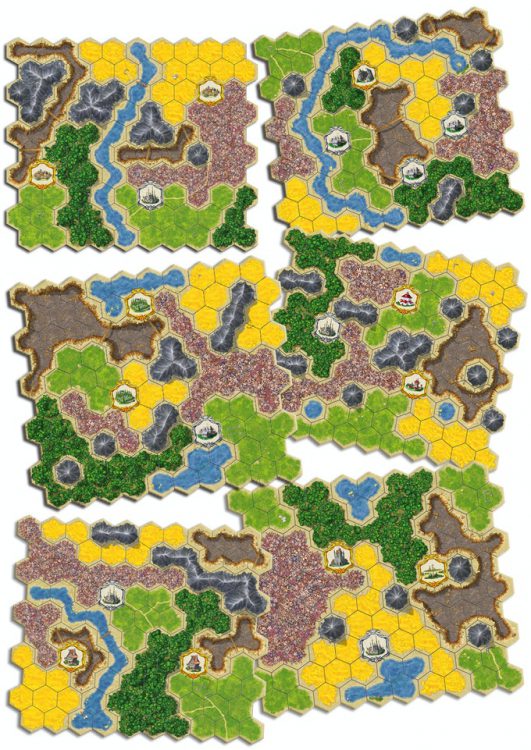
Each time you place a settlement, you must always place it adjacent to one of your existing settlements, if you can. That “if you can” is what makes the game go from “good” to “Game of the Year 2012”. Imagine you draw a “Desert” card, and have no settlements adjacent to open desert spaces. That means you can place your settlement on any open desert space on the entire board, anywhere. Plan ahead. Purposefully cut yourself off from a terrain type, so that you can jump around the map. Force your opponents to take bad moves so they can’t do the same. Unlock special abilities that you can use every turn to place extra settlements or move existing ones. Take twenty minutes on your turn to figure out the precise order to perform all your actions in order to maximize your score, then realize it was all for naught when your opponent slams down the perfect settlement and takes the lead.
But how do you actually “win” it. What are the victory conditions? This is another area that makes Kingdom Builder stand out from other games in the same genre. One playthrough might have you scoring points by building a single massive cluster of settlements, and the next might have you rewarded for building as many tiny disconnected settlements as you can. Maybe the next will have you doing both, while also scoring victory points for building on separate horizontal lines of the game grid. Each game starts by drawing three random scoring conditions from a deck of ten (mathsnipe: that’s 120 different combinations) that everyone will be working towards.
Even outside the gameplay, Kingdom Builder is remarkably well put together. Good use of iconography reduces the game’s language barrier. Relatively simple unconditional rules make the game cognitively easier to follow than many heavier Eurogames. Smart use of colors makes the game accessible to many forms of color vision deficiency (though it’s not perfect in that regard), and a complete lack of hidden information means asking for or providing assistance to a friend won’t reveal anything that’s supposed to remain hidden.
While it’s not a perfect game, it stands leagues ahead of many similar games. Each turn is simple, but winning tactics are complex. The options you have are limited but every choice you make is impactful. It’s competitive without being mean, and it’s quick to play with each game being memorable. Kingdom Builder is balanced, incredibly fun, and a strong contender in its bracket.
Alhambra
Winner of the Spiel des Jahres in 2003, Alhambra is one of those games that seems very straightforward at first, but for which the complexity really starts to dawn on you as the game progresses.
At its core, Alhambra is a construction game, with each player trying to build a palace fit for a sultan. This is accomplished by buying and placing square tiles consisting of six different building types – pavilions, seraglios, arcades, chambers, gardens, and towers. But like any good sultan, you want to keep the riff-raff out of your palace, so of course it has to have walls. As such, each of the tiles will have from zero to three sides with a heavy black border representing a wall. The rules of tile placement stipulate that walls (or no walls) along adjoining edges of adjacent tiles have to match, and further that you can’t “wall off” any tile – in other words, a “pedestrian” in your starting fountain square must be able to walk freely to any tile in your palace without leaving your tiles or crossing a wall.
Initially, of course, this is a snap! But as your palace becomes larger, things necessarily become more complicated, and tile placement that follows all of the requirements becomes increasingly tricky. What makes it even trickier is that one of your idiot friends is inevitably going to buy that perfect tile you’ve been eyeing for three turns.
Tile purchase is where the meat of the game lies, because it’s not as simple as just shelling out some cash and calling it a day. No, your sultan runs a cosmopolitan city in which there are four different currencies, and masons, architects, gardeners, and artisans all demand payment in their native denomination of cash. In any given player turn, there are four different money cards (with values ranging from 2 to 9) face up, and these will be of a random assortment of the four colors: yellow, blue, green, and orange, each of which also has a helpful symbol for folks with colorblindness, one of this game’s charming details. Similarly, there are four tiles for sale on the marketplace, each of which has a cost (on the tile itself) and a type of money that can be used to purchase it (based on the tile’s position in the marketplace). So if there’s a seraglio with a cost of 6 on the blue cash slot, you can only purchase it with at least 6 blue money. I say “at least” because with the values of the various cards you may be holding, you often end up having to overpay for tiles and you don’t get change – those artisans drive a hard bargain!
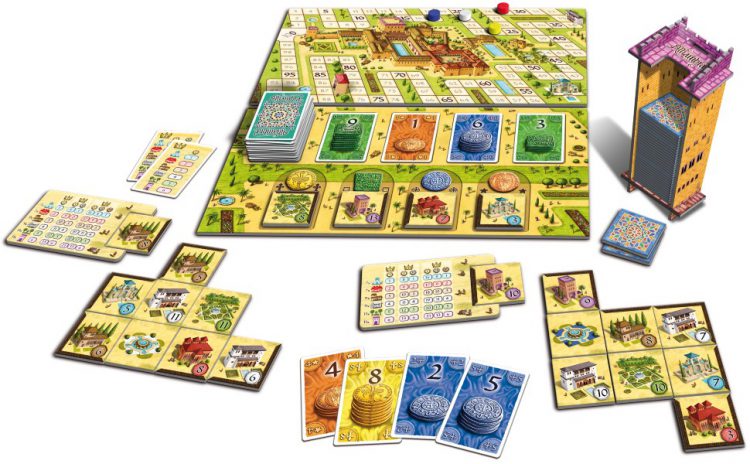
Players may take one action per turn – take a single face-up money card (or multiple if they add up to 5 or less), buy a single tile, or rearrange a tile from their reserve to their palace. If you choose to buy a tile and can pay its exact purchase cost, you get to take another action immediately, but crucially the supply of face-up money cards and tiles available for purchase isn’t replenished until the end of your turn – what you see is what your options are.
Scoring is triggered by encountering “scoring” cards that have been seeded into the money deck, and Alhambra was one of the first games I remember playing that used this mechanic (something that is core to the operation of later games like the “Epidemic!” cards in Pandemic). There will be two mid-game scoring rounds and a final scoring round at the end of the game when all of the building tiles have been purchased. Scoring is based on who has the most buildings of each type in their Alhambra, with pavilions scoring the fewest points (but generally being cheaper to purchase) and towers offering the most (but these are the most expensive). Here too there is a clever mechanic at play, which is that if two players tie for the highest number of a certain building, they share the combined points for first and second place, rounding down, setting the stage for great “spoiler” moves. Additionally, you get points for having the longest exterior wall – remember how I said tile placement gets tricky? Well here is a big reason why.
And herein lies the wonder of Alhambra – game play is ridiculously and deceptively simple; you’re either taking money or buying buildings for your palace. But do you have the right color of money for the tile you desperately want? Do you make a sub-optimal purchase but do it with exact change to get another action? Do you purchase that last seraglio even knowing you can’t place it because it will force a tie between two other players in the final scoring? Do you spend a turn rearranging two of your tiles – neither taking money nor buying new buildings – in order to set yourself up for future expansion or a longer wall? The decisions you make as a player feel interesting and impactful, which is exactly what I look for in games.
Manhattan
Are you ready for the ruthless, backstabbing world of high finance and skyscraper building? No? Fine, how about a dynamic tactical game of putting pretty plastic pieces on top of one another to claim as many stacks as you can? While the theme of the game is weak, the somewhat abstract gameplay is not and there is a lot of fun in this game!
Manhattan is a game for two to four players, and best played with people who understand that everyone else will be interfering in the plans of others and trying to take over their towers. If you aren’t on top, you don’t own it! You will tussle against the other players over five regions, each of which are split into a 3×3 grid of spaces.
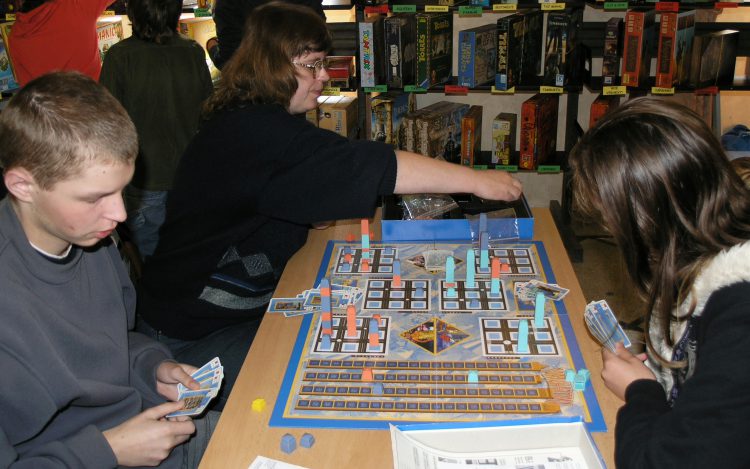
You begin the game with a set of tower pieces in four different sizes, but you will have to limit your options each round by picking only a small portion of these to use. You will place them all eventually, but when to include your bigger towers is a crucial choice. You also draw a hand of four cards, each of which highlight a space on a 3×3 grid, the same grid as in each region.
Each turn, you play a card and put one of your tower pieces on the space it indicates in a region of your choice, but only if you can follow the rules! Either the space is empty, or you already own the tower there. If someone owns that tower, you can take it over! As long as after you have placed a piece on that tower, you have at least as many floors in your color (not pieces!) in that tower as the player who owned it last! As you only get to place one piece at a time, timing when to use your bigger pieces to take over or defend a tower is fundamental to success in this game.
Scoring happens at the end of each of the game rounds – points for who has built the highest tower overall, who owns the most towers in each of the five regions, and then points for each tower regardless. At the end of the game, lifelong friendships don’t matter, only points do so take their towers! The new 2018 version thankfully replaces the racial stereotypes used on the original with more inclusive art, with colored transparent tower pieces too!
Special thanks to Ben O’Steen for contributing this write up.
Scotland Yard
Scotland Yard joined the bracket as a Play-In Game Winner and at this point it’s just happy to be here. It’ll enjoy some TV time, it’s moment under the lights, take home a commemorative t-shirt, and tell the grandkids about it one day.
Catan
First published in 1995 (and previously known as Settlers of Catan), Catan is essentially the Dungeons and Dragons of modern board games, with everything that simile entails. With more than 22 million copies sold in 39 languages, it has quickly become one of the most popular board games in the world and for millions of Americans, Catan has been the quintessential gateway into board games. For people who grew up on games like Monopoly and Candyland, Catan was the revelation that board games could actually be fun to play. If you’ve only played one game in the bracket, there’s a good chance that it’s either Catan or Rummikub.
Catan is a game of resource collection and social interaction. Players take on the roles of rival groups of settlers on the island of Catan, collecting five resources – Sheep (Wool), Wheat, Ore, Wood, and Brick – and using those resources to build settlements, cities, roads, and purchase development cards that give them additional effects or allow them to build and bolster armies. Players have an ongoing score based on the size and number of their settlements, having the longest road, and having the largest army. Each round resources are randomly generated based on players’ settlement locations on the board (each tile has a number between 2 and 12 for generating resources from the turn’s dice roll) and players can then trade resources.

The trading aspect is one area Catan shines – besides giving us the classic line “I’ve got wood for sheep,” this creates a social interaction aspect where players can attempt to barter and set up dastardly plans by fleecing opponents. And should no one be willing to trade, the game includes a trade-in mechanic where players can exchange resources on a 4-for-1 basis or better, if they have a seaport settlement.
Catan’s popularity is a double-edged sword, however: While the game is a popular entry point to board games for many, it has, over the course of the last twenty or so years, developed a bit of a negative reputation in board game circles. The game’s mechanics, though workable, are a bit clunky and dated – for every good thing Catan does, there’s a more modern game that does that thing better. Additionally, the game has some kingmaker issues and trying to win in the final rounds with an entire table working against you can be a real chore. And the game tying resource generation to dice rolls means its very possible to have a game where you just end up never having the resources to really play thanks to some bad luck. There are some legitimate grips to be had with the game. On the other hand, it’s hard to discount that a good chunk of the grousing from board game communities is just hating on the thing with mainstream popularity.
Despite its flaws, Catan is a fun and engaging game and it’s easy to sit down and play 2-3 games in an evening with friends or coworkers and it’s a great stepping stone to more involved games. The game is a cultural juggernaut for a reason.
Bracket Wrap-Up
Our first entrant into the Sweet 16 is Azul, followed closely by Catan. These are both easy advances over the Play-In Game winners who deserve their Spiel in every way, but they have been eclipsed over the years. The other two games are much closer. Tiffany did a fantastic game in pitting these against each other as well. Kingdom Builder and Camel Up both come in on the more accessible scale meaning we’ve got a clash of the “Gateway Games” in this one. Kingdom Builder is deeper and has longer legs than Camel Up, but Camel Up has way more exciting components and the latest edition adds “Wild Camels” that run the wrong way and mess stuff up. I’ll take zany any day and give it to Camel Up in a very close one; they’re both losing to Azul anyway which cruises to the Elite 8.
On the bottom half of the bracket, Catan crushes Scotland Yard from the opening tip but Scotland Yard doesn’t mind and takes selfies with Klaus Teuber on the sidelines before they leave. Alhambra and Manhattan is another close matchup. Neither game makes waves these days, though both had their days in the sun. Alhambra is great tile-laying fun and still worth checking out, and Manhattan’s recent edition breathes fresh life into this area control classic. This one goes to overtime, but fresher area control is going to get it from me over older tile-laying. Again though, they’re both losing to Catan setting up a titanic clash in the Elite 8.
Bracket Winner – Azul
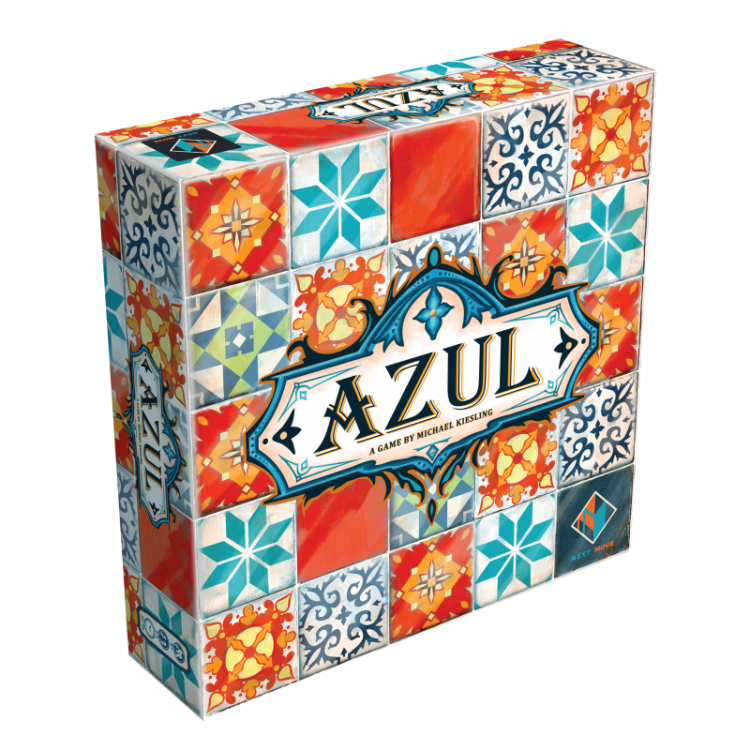
Don’t call it an upset, there’s a reason Azul was our number 1 seed. While we expect that most had Catan penciled in to the Final 4 and possibly to win the thing, we’re just going to be blunt here and say that Catan no longer has the gas. It’s a classic and is the best selling hobby board game of all time for a reason, but time has started to take a little of the shine off this venerable titan. Catan does a lot of things—trading, risk management, building, routes—but over time we’ve found games that do all of those things better. Sure, if you want all of those things in a single package Catan is right where it’s been for decades but for any other situation you can look elsewhere.
Honestly, back in our editorial chat this battle wasn’t particularly close. There is still a lot of love for Catan’s ability to get someone into gaming and bridge them to more complex stuff but Azul is plenty capable of that too. On the other hand, Azul has a nearly 100% hit right for anyone I’ve ever played this game with. Yeah Catan went into halftime only down 5 or 6 with a path to victory, but Azul came out with lockdown defense. New gamers, old gamers, young gamers, you name it and everyone is drawn to the bright tiles and tense decisions of Azul.


